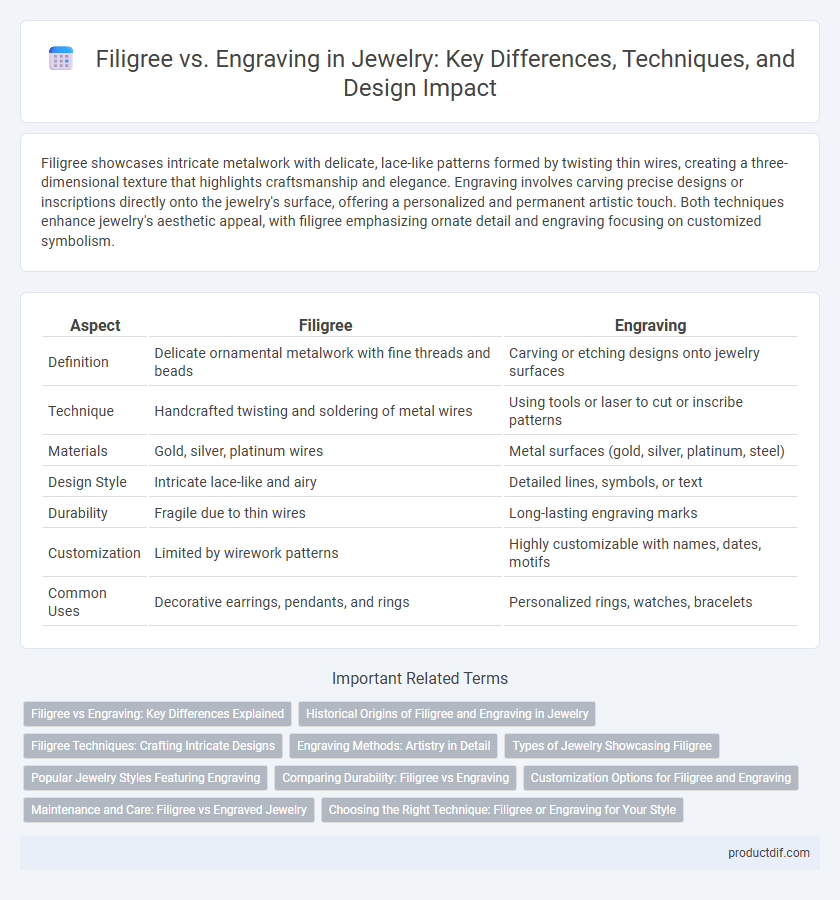Filigree showcases intricate metalwork with delicate, lace-like patterns formed by twisting thin wires, creating a three-dimensional texture that highlights craftsmanship and elegance. Engraving involves carving precise designs or inscriptions directly onto the jewelry's surface, offering a personalized and permanent artistic touch. Both techniques enhance jewelry's aesthetic appeal, with filigree emphasizing ornate detail and engraving focusing on customized symbolism.
Table of Comparison
| Aspect | Filigree | Engraving |
|---|---|---|
| Definition | Delicate ornamental metalwork with fine threads and beads | Carving or etching designs onto jewelry surfaces |
| Technique | Handcrafted twisting and soldering of metal wires | Using tools or laser to cut or inscribe patterns |
| Materials | Gold, silver, platinum wires | Metal surfaces (gold, silver, platinum, steel) |
| Design Style | Intricate lace-like and airy | Detailed lines, symbols, or text |
| Durability | Fragile due to thin wires | Long-lasting engraving marks |
| Customization | Limited by wirework patterns | Highly customizable with names, dates, motifs |
| Common Uses | Decorative earrings, pendants, and rings | Personalized rings, watches, bracelets |
Filigree vs Engraving: Key Differences Explained
Filigree and engraving differ primarily in technique and visual effect; filigree involves delicate metalwork crafted into intricate lace-like designs using fine wires, while engraving entails carving detailed patterns or inscriptions directly onto the jewelry surface. Filigree showcases elevated craftsmanship through three-dimensional artistry, frequently seen in vintage and bridal jewelry. Engraving offers personalized customization and elegance, commonly applied for names, dates, or symbolic motifs on rings and pendants.
Historical Origins of Filigree and Engraving in Jewelry
Filigree, originating from ancient Mesopotamia and later flourishing in Mediterranean cultures, involves intricate metalwork using twisted threads of gold or silver, showcasing delicate lace-like patterns in jewelry design. Engraving has roots in ancient Egypt and Greece, where artisans meticulously carved detailed motifs directly onto metal surfaces, serving both decorative and symbolic purposes. Both techniques demonstrate the evolution of jewelry craftsmanship, reflecting cultural heritage through their distinct artistic approaches.
Filigree Techniques: Crafting Intricate Designs
Filigree techniques involve twisting fine threads of metal, typically gold or silver, into delicate lace-like patterns that create intricate and airy designs in jewelry. This handcrafted method emphasizes precision and artistic skill, resulting in ornamental pieces that showcase openwork and detailed motifs. Unlike engraving, which carves or etches patterns directly onto a solid surface, filigree builds designs by assembling tiny metal components for a three-dimensional effect.
Engraving Methods: Artistry in Detail
Engraving methods in jewelry, such as hand engraving, laser engraving, and acid etching, showcase artistry in detail by allowing intricate and precise designs to be etched onto metal surfaces. Hand engraving uses specialized tools for depth and texture variation, while laser engraving offers unmatched accuracy for complex patterns and customization. These techniques enhance the visual appeal and personalization of jewelry, distinguishing it from filigree's delicate wirework craftsmanship.
Types of Jewelry Showcasing Filigree
Filigree jewelry features delicate, lace-like designs crafted from fine metal threads, commonly showcased in rings, earrings, pendants, and bracelets. This intricate technique highlights vintage and antique styles often seen in heirloom and statement pieces, emphasizing craftsmanship and detailed metalwork. Unlike engraving, which involves carving designs into the metal surface, filigree creates a three-dimensional, openwork pattern that enhances the jewelry's elegance and lightness.
Popular Jewelry Styles Featuring Engraving
Popular jewelry styles featuring engraving include signet rings, lockets, and personalized bracelets, where intricate text or designs are etched to create meaningful, custom pieces. Unlike filigree, which emphasizes delicate wirework and ornamental patterns, engraving focuses on precise surface details that capture names, dates, or symbolic motifs. Engraved jewelry remains a timeless choice for commemorative gifts and heirloom-quality accessories.
Comparing Durability: Filigree vs Engraving
Filigree jewelry, crafted from delicate twisted wires, is more susceptible to bending and damage due to its intricate, openwork design, whereas engraving involves etching patterns directly onto a solid metal surface, providing greater long-term durability. Engraved pieces withstand daily wear better because the design is embedded into the metal, minimizing the risk of deformation or loss of detail. Choosing between filigree and engraving depends on desired aesthetics and how much durability is prioritized for regular use.
Customization Options for Filigree and Engraving
Filigree offers intricate, lace-like metalwork that allows for delicate, three-dimensional customization, emphasizing ornate patterns and fine details crafted by hand or precision tools. Engraving provides personalized customization through detailed inscriptions or designs etched directly onto the jewelry surface, enabling text, symbols, or motifs to enhance sentimental value. Both techniques cater to unique customization needs, with filigree favoring elaborate structural embellishments and engraving focusing on precise surface personalization.
Maintenance and Care: Filigree vs Engraved Jewelry
Filigree jewelry requires delicate handling and gentle cleaning with a soft brush to prevent damage to its intricate wire designs, while engraved jewelry is more durable and easier to maintain using regular polishing cloths. Filigree's openwork structure demands careful storage to avoid tangling or bending, whereas engraved pieces resist wear and scratches better due to their solid metal surface. Proper care of filigree enhances its intricate aesthetic, whereas consistent cleaning preserves the sharp details and depth of engraved patterns.
Choosing the Right Technique: Filigree or Engraving for Your Style
Filigree offers intricate, delicate patterns crafted from fine metal threads, perfect for those seeking a vintage or ornate look, while engraving provides precise, personalized designs etched directly onto the jewelry surface, ideal for minimalist or custom inscriptions. Choosing between filigree and engraving depends on your style preference, whether you favor detailed texture and craftsmanship or sleek, meaningful symbolism. Consider the jewelry type and occasion, as filigree suits statement pieces, whereas engraving enhances everyday wear with subtle elegance.
Filigree vs Engraving Infographic

 productdif.com
productdif.com